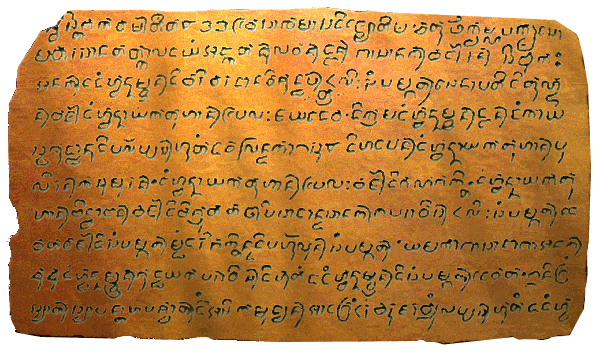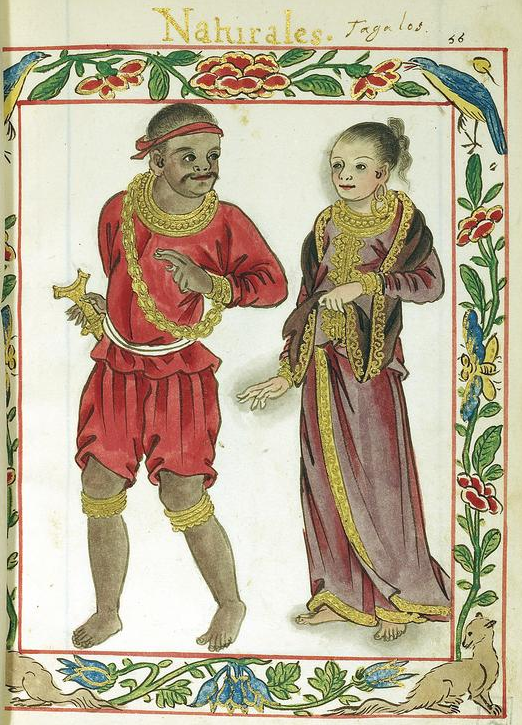|
History Of The Philippines (900–1565)
The recorded pre-colonial history of the Philippines, sometimes also referred to as its "protohistoric period" begins with the creation of the Laguna Copperplate Inscription in 900 CE and ends with the beginning of Spanish colonization in 1565. The inscription on the Laguna Copperplate Inscription itself dates its creation to 822 Saka (900 CE). The creation of this document marks the end of the prehistory of the Philippines at 900 AD, and the formal beginning of its recorded history. During this historical time period, the Philippine archipelago was home to numerous kingdoms and sultanates and was a part of the Indosphere and Sinosphere. Sources of precolonial history include archeological findings; records from contact with the Song dynasty, the Brunei Sultanate, Korea, Japan, and Muslim traders; the genealogical records of Muslim rulers; accounts written by Spanish chroniclers in the 16th and 17th centuries; and cultural patterns that at the time had not yet been repla ... [...More Info...] [...Related Items...] OR: [Wikipedia] [Google] [Baidu] |
Southeast Asia
Southeast Asia is the geographical United Nations geoscheme for Asia#South-eastern Asia, southeastern region of Asia, consisting of the regions that are situated south of China, east of the Indian subcontinent, and northwest of the Mainland Australia, Australian mainland, which is part of Oceania. Southeast Asia is bordered to the north by East Asia, to the west by South Asia and the Bay of Bengal, to the east by Oceania and the Pacific Ocean, and to the south by Australia (continent), Australia and the Indian Ocean. Apart from the British Indian Ocean Territory and two out of Atolls of the Maldives, 26 atolls of the Maldives in South Asia, Maritime Southeast Asia is the only other subregion of Asia that lies partly within the Southern Hemisphere. Mainland Southeast Asia is entirely in the Northern Hemisphere. Timor-Leste and the southern portion of Indonesia are the parts of Southeast Asia that lie south of the equator. The region lies near the intersection of Plate tectonics, ... [...More Info...] [...Related Items...] OR: [Wikipedia] [Google] [Baidu] |
Prehistory Of The Philippines
The prehistory of the Philippines covers the events prior to the recorded history, written history of what is now the Philippines. The current demarcation between this period and the History of the Philippines (900–1521), early history of the Philippines is April 21, 900, which is the equivalent on the Proleptic Gregorian calendar for the date indicated on the Laguna Copperplate Inscription—the earliest known surviving written record to come from the Philippines. This period saw the immense change that took hold of the archipelago from Stone Age cultures in 50000 BC to the emergence of developed Thalassocracy, thalassocratic civilizations in the fourth century, continuing on with the gradual widening of trade until 900 and the first surviving written records. Pleistocene Kalinga artifacts and fossil fauna remains A 2018 study led by Thomas Ingicco, which analyzed rhino remains unearthed in Rizal Archaeological Site (Kalinga), Rizal Archaeological Site in Kalinga using sev ... [...More Info...] [...Related Items...] OR: [Wikipedia] [Google] [Baidu] |
Japan
Japan is an island country in East Asia. Located in the Pacific Ocean off the northeast coast of the Asia, Asian mainland, it is bordered on the west by the Sea of Japan and extends from the Sea of Okhotsk in the north to the East China Sea in the south. The Japanese archipelago consists of four major islands—Hokkaido, Honshu, Shikoku, and Kyushu—and List of islands of Japan, thousands of smaller islands, covering . Japan has a population of over 123 million as of 2025, making it the List of countries and dependencies by population, eleventh-most populous country. The capital of Japan and List of cities in Japan, its largest city is Tokyo; the Greater Tokyo Area is the List of largest cities, largest metropolitan area in the world, with more than 37 million inhabitants as of 2024. Japan is divided into 47 Prefectures of Japan, administrative prefectures and List of regions of Japan, eight traditional regions. About three-quarters of Geography of Japan, the countr ... [...More Info...] [...Related Items...] OR: [Wikipedia] [Google] [Baidu] |
Korea
Korea is a peninsular region in East Asia consisting of the Korean Peninsula, Jeju Island, and smaller islands. Since the end of World War II in 1945, it has been politically Division of Korea, divided at or near the 38th parallel north, 38th parallel between North Korea (Democratic People's Republic of Korea; DPRK) and South Korea (Republic of Korea; ROK). Both countries proclaimed independence in 1948, and the two countries fought the Korean War from 1950 to 1953. The region is bordered by China to the north and Russia to the northeast, across the Yalu River, Amnok (Yalu) and Tumen River, Duman (Tumen) rivers, and is separated from Japan to the southeast by the Korea Strait. Known human habitation of the Korean peninsula dates to 40,000 BC. The kingdom of Gojoseon, which according to tradition was founded in 2333 BC, fell to the Han dynasty in 108 BC. It was followed by the Three Kingdoms of Korea, Three Kingdoms period, in which Korea was divided into Goguryeo, Baekje, a ... [...More Info...] [...Related Items...] OR: [Wikipedia] [Google] [Baidu] |
Bruneian Sultanate (1368–1888)
Brunei, officially Brunei Darussalam, is a country in Southeast Asia, situated on the northern coast of the island of Borneo. Apart from its coastline on the South China Sea, it is completely surrounded by the Malaysian state of Sarawak, with its territory bifurcated by the Sarawak district of Limbang. Brunei is the only sovereign state entirely on Borneo; the remainder of the island is divided between its multi-landmass neighbours of Malaysia and Indonesia. , the country had a population of 455,858, of whom approximately 180,000 resided in the capital and largest city of Bandar Seri Begawan. Its official language is Malay, and Islam is the state religion of the country, although other religions are nominally tolerated. The government of Brunei is an absolute monarchy ruled by the Sultan, and it implements a fusion of English common law and jurisprudence inspired by Islam, including sharia. At the Bruneian Empire's peak during the reign of Sultan Bolkiah (1485–1528), t ... [...More Info...] [...Related Items...] OR: [Wikipedia] [Google] [Baidu] |
Song Dynasty
The Song dynasty ( ) was an Dynasties of China, imperial dynasty of China that ruled from 960 to 1279. The dynasty was founded by Emperor Taizu of Song, who usurped the throne of the Later Zhou dynasty and went on to conquer the rest of the Five Dynasties and Ten Kingdoms period#Ten Kingdoms, Ten Kingdoms, ending the Five Dynasties and Ten Kingdoms period. The Song frequently came into conflict with the contemporaneous Liao dynasty, Liao, Western Xia and Jin dynasty (1115–1234), Jin dynasties in northern China. After retreating to southern China following attacks by the Jin dynasty, the Song was eventually conquered by the Mongol-led Yuan dynasty. The History of the Song dynasty, dynasty's history is divided into two periods: during the Northern Song (; 960–1127), the capital was in the northern city of Bianjing (now Kaifeng) and the dynasty controlled most of what is now East China. The #Southern Song, 1127–1279, Southern Song (; 1127–1279) comprise the period following ... [...More Info...] [...Related Items...] OR: [Wikipedia] [Google] [Baidu] |
Archaeology Of The Philippines
The archaeology of the Philippines is the study of past societies in the territory of the modern Republic of the Philippines, an island country in Southeast Asia, through material culture. The history of the Philippines focuses on Spanish colonialism and how the Philippines became independent from both Spain and the United States. During the colonial times in the Philippines archaeology was not used as it is today, it mainly focused on ethnographic and linguistic studies. Archaeology was influenced greatly by H. Otley Beyer who taught anthropology in the Philippines in 1914. Beyer's teachings in the Philippines gained many students to follow in his footsteps into the field of archaeology. After the Philippines gained their independence from America in 1946, many students of Beyer practiced archaeology all over the Philippines. A few of Beyer's students and colleagues who worked around the Philippines are Robert B. Fox, Alfredo Evangelista, and F. Landa Jocano. Their contrib ... [...More Info...] [...Related Items...] OR: [Wikipedia] [Google] [Baidu] |




